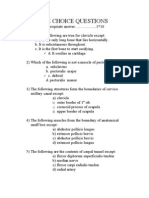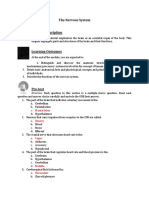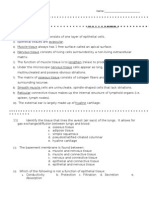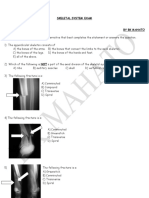100%(1)100% found this document useful (1 vote)
771 viewsSkeletal System Unit Test
The document is a quiz on skeletal system anatomy. It contains 30 multiple choice questions testing knowledge of bones, joints, cartilage, and other skeletal structures and tissues. The questions cover topics like the number of bones in the human body, functions of different bones and joints, differences between bone types, and bone cells and tissues.
Uploaded by
HONLETH ROMBLONCopyright
© © All Rights Reserved
Available Formats
Download as DOCX, PDF, TXT or read online on Scribd
100%(1)100% found this document useful (1 vote)
771 viewsSkeletal System Unit Test
The document is a quiz on skeletal system anatomy. It contains 30 multiple choice questions testing knowledge of bones, joints, cartilage, and other skeletal structures and tissues. The questions cover topics like the number of bones in the human body, functions of different bones and joints, differences between bone types, and bone cells and tissues.
Uploaded by
HONLETH ROMBLONCopyright
© © All Rights Reserved
Available Formats
Download as DOCX, PDF, TXT or read online on Scribd
You are on page 1/ 2
Name: _______________________________________ Teacher: _____________________ Score:
1. What is the skeletal system?
A. All the bones in the body C. All the muscles and tendons
B. All the body's organs, both soft and hard tissue D. All the bones in the body and the tissues
that connect them
2. How many bones are there in the average person's body?
A. 33 B. 206 C. 639 D. It varies by the individual.
3. Which of the following statement is INCORRECT?
A. Bone is where most blood cells are made. C. Bone serves as a storehouse for various minerals.
B. Bone is a dry and non-living supporting structure. D. Bone protects and supports the body and its organs.
4. Which bone protects the brain?
A. Calcium B. The cranium C. The cerebrum D. The cerebellum
5. Besides the brain, the skull also protects ...
A. the lungs B. the diaphragm C. the body's cells D. the sense organs
6. The purpose of the rib cage is to...
A. protect the stomach C. protect the spinal cord
B. protect the heart and lungs D. provide an object to which the lungs can attach
7. What makes bones so strong?
A. Silica B. Cartilage C. Blood and marrow D. Calcium and phosphorous
8. What is the difference between cartilage and bone?
A. Bone is rubbery, and cartilage is firm. C. Bone is a more primitive tissue than cartilage.
B. Cartilage is rubbery, and bone is firm. D. Bone is inside the body, and cartilage is outside.
9. The hollow space in the middle of bones is filled with ...
A. Air B. blood C. bone cells D. bone marrow
10. What is the difference between compact bone and spongy bone?
A. They have different bone marrow. C. They are made of different materials.
B. They have different sizes of bone cells. D. They have different arrangement of bone cells.
11. What is a joint?
A. A hinge C. The place where two bones are joined
B. A ball and socket D. The place where tendons are fastened together
12. How do muscles attached to the bones move the body?
A. Automatically B. pull movement only C. push movement only D. push and
pull movement
13 What is the function of a tendon?
A. To link bones to bones C. To link muscles to bones
B. To link muscles to ligaments D. To bind the cells in compact bone closer together
14. A group of similar cells that perform a single function is called a(an)
A. nerve. B. organ. C. tissue. D. organ system.
15. Which of the following is NOT part of the axial skeleton?
A. skull B. vertebral column C. pelvis D. rib cage
16. Which of the following contains nerves and blood vessels and runs through the compact bone?
a. osteocytes b. Haversian canals c. bone marrow d. periosteum
17. Which of the following is true about red marrow?
a. It makes blood cells. b. It produces new bone. c. It stores fat. d. It is found in compact bones of adults
18. The periosteum is a
a. place for storing fat cells. c. location for red blood cell production.
b. tough layer of connective tissue surrounding a bone. d. lattice work structure that adds strength to the bone.
19. Ligaments connect
a. cartilage to bone. b. bone to muscle. c. muscle to muscle. d. bone to bone.
20. The type of joint in your knee is a _____________ joint.
a. hinge b. ball & socket c. gliding d. fixed
21. The type of joint found in your shoulder is a _____________ joint.
a. gliding b. ball & socket c. hinge d. fixed
22. One important function of bones is to produce _____________.
a. tendons b. blood cells c. ligaments d. cartilage
23. A condition in which bones become weak and break easily is called ____________.
a. osteoporosis b. rickets c. arthritis d. acne
24. A bone break that pierces or ruptures through the skin is a ____.
a. depressed fracture b. simple fracture c. greenstick fracture d. compound fracture
25. The neck and hip contain this type of joint.
a. Immovable b. Gliding c. Movable d. Hinge
26. This joint consists of a bone with a rounded end that fits into a cup-like cavity on another bone.
a. Pivot b. Ball and socket c. Hinge d. Gliding
27. At birth, your skeleton was made up of _____________ bones
a. a greater number of b. the same number of c. a smaller number of d. no
28. This joint has a back and forth movement like a door.
a. Ball and socket b. Gliding c. Hinge d. Pivot
29. This joint can give more range of motion than other joints
a. Hinge b. Gliding c. Ball and socket d. Pivot
30. Bone-forming cells are called _______.
a. Osteocasts b. Osteoclasts
c. Osteobasts
d. Osteoblasts
Label the illustration
You might also like
- Respiratory System Review Practice Test PDF100% (3)Respiratory System Review Practice Test PDF5 pages
- Curriculum Guide For Reasearch Grade 10 Subject DescriptionNo ratings yetCurriculum Guide For Reasearch Grade 10 Subject Description3 pages
- The Diagram Below Represents An Unlabeled Skeleton. Which Part Does Each Number Represents?No ratings yetThe Diagram Below Represents An Unlabeled Skeleton. Which Part Does Each Number Represents?6 pages
- Skeletal and Muscular System Review Test Answers PDFNo ratings yetSkeletal and Muscular System Review Test Answers PDF9 pages
- Chaper 6 Osseous Tissue and Bone StructureNo ratings yetChaper 6 Osseous Tissue and Bone Structure25 pages
- Skeletal System Exam Multiple-Choice: Choose The One Alternative That Best Completes The Statement or Answers The Question100% (1)Skeletal System Exam Multiple-Choice: Choose The One Alternative That Best Completes The Statement or Answers The Question3 pages
- Anatomy Physiology The Muscular System MCQ Quiz100% (1)Anatomy Physiology The Muscular System MCQ Quiz32 pages
- Integumentary System General Directions: Answer The Following Questions Intelligently and Supply AllNo ratings yetIntegumentary System General Directions: Answer The Following Questions Intelligently and Supply All4 pages
- Anatomy and Physiology Midterm Chapter Quiz Skeletal and Muscular System Skeletal SystemNo ratings yetAnatomy and Physiology Midterm Chapter Quiz Skeletal and Muscular System Skeletal System8 pages
- MUHS Invite Anatomy & Physiology Division C Exam SP24No ratings yetMUHS Invite Anatomy & Physiology Division C Exam SP2416 pages
- Grade 7 Science: Unit 4 Earth AND SpaceNo ratings yetGrade 7 Science: Unit 4 Earth AND Space36 pages
- Vocabulary Quiz - (1D Motion) WednesdayNo ratings yetVocabulary Quiz - (1D Motion) Wednesday11 pages
- 1 - The Skeletal System and Its FunctionNo ratings yet1 - The Skeletal System and Its Function9 pages
- SHENIBLOG-Kerala Class 9 Biology - Unit 4 (Eng Med) - Simplified Coloured Notes 2024 - Rasheed OdakkalNo ratings yetSHENIBLOG-Kerala Class 9 Biology - Unit 4 (Eng Med) - Simplified Coloured Notes 2024 - Rasheed Odakkal4 pages
- Gov. M. Cueco Ave., Banilad Mandaue City 6014, Cebu PhilippinesNo ratings yetGov. M. Cueco Ave., Banilad Mandaue City 6014, Cebu Philippines43 pages
- Unit 1 Anatomy, Physiology and The Human Body: Learning OutcomesNo ratings yetUnit 1 Anatomy, Physiology and The Human Body: Learning Outcomes91 pages
- Instant Download (Ebook) Spycraft University by BN Miles PDF All Chapters100% (5)Instant Download (Ebook) Spycraft University by BN Miles PDF All Chapters75 pages
- Class 8th STD Science Term II Book Back - WWW - Governmentexams.co - inNo ratings yetClass 8th STD Science Term II Book Back - WWW - Governmentexams.co - in26 pages
- Ecz Grade 10 - 12 Biology Summarised Notes (Locomotion and The Skeleton) With Exam Questions and Answers100% (1)Ecz Grade 10 - 12 Biology Summarised Notes (Locomotion and The Skeleton) With Exam Questions and Answers15 pages
- NAME: Christan Y. Tabia SECTION: B1-G12-05-STEM STM 007: General Biology 1 2 Performance TaskNo ratings yetNAME: Christan Y. Tabia SECTION: B1-G12-05-STEM STM 007: General Biology 1 2 Performance Task12 pages
- GRADE 5 SCIENCE AND TECHNOLOGY1 Full, Edited and CompleteNo ratings yetGRADE 5 SCIENCE AND TECHNOLOGY1 Full, Edited and Complete64 pages
- Skeletal System: Grade 3 Elm Roll No 19No ratings yetSkeletal System: Grade 3 Elm Roll No 1912 pages









































































































